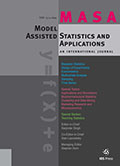Authors: Thamanukornsri, Chompunooch | Tiensuwan, Montip
Article Type:
Research Article
Abstract:
In this paper, we focus on monthly number of dengue cases in Thailand using the univariate Box-Jenkins (seasonal ARIMA) and GARCH models. There are 3 types of dengue i.e. dengue fever (DF), dengue hemorrhagic fever (DHF), and dengue shock syndrome (DSS). These series are fitted with adjustment by population size and seasonal index. For each type, the best model is choosen by Akaike’s Information Criteria (AIC) and Schwartz’s Bayesian Criteria (SBC). A comparison of the fitted Box-Jenkins and GARCH models are presented using root mean square error (RMSE) and mean absolute percentage error (MAPE). The results showed that the best
…fitted for the univariate Box-Jenkins models of DF, DHF and DSS cases are seasonal ARIMA(0, 1, 1) × (0, 1, 1) 12 , ARIMA(0, 1, 1) × (0, 1, 1) 12 and ARIMA(0, 1, 3) × (0, 1, 1) 12 , respectively, while the best fitted GARCH models of DF, DHF and DSS cases are AR(1)-GARCH(1, 1) adjusted seasonal components, AR(8)-ARCH(1) removed seasonal components and AR(1)-ARCH(1) adjusted seasonal components, consequently. Further, from a comparison the GARCH model outperforms than the univariate Box-Jenkins (seasonal ARIMA) model. Removing seasonal components technique increased efficiency of fitting model in GARCH method while adjustment by population size did not give a significantly difference result to both methods.
Show more
Keywords: Dengue fever, dengue hemorrhagic fever, dengue shock syndrome, population size, seasonal index
DOI: 10.3233/MAS-180422
Citation: Model Assisted Statistics and Applications,
vol. 13, no. 2, pp. 95-105, 2018
Price: EUR 27.50





